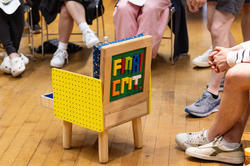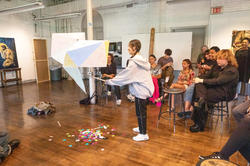The 2023–24 academic year comes to a close with final crits in studios across campus.
First-Year RISD Students Learn the Art of Critique

First-year undergraduate students at RISD are immersed in making, developing their skills and finding inspiration and context for their work in studios, liberal arts classes and everything they see around them. Through the process of asking questions and iterating, they refine their work and learn to take each project from conception to completion. A key element in the process is critique—both giving and receiving constructive criticism—and developing that skill is an important part of the Experimental and Foundation Studies (EFS) curriculum.
Students in an EFS Design studio led by Associate Professor Mimi Cabell MFA 11 PH are sharing pieces in a variety of mediums they’ve created in response to the prompt “become a cowboy.” The goal of the exercise is to convey meaningful messages through objects, spaces and experiences that consider the cultural and historical aspects of the subject matter while demonstrating the core design principles they’re studying.
Cabell kicked off the project with a wide range of references, from the 19th-century Mexican vaqueros who inspired cowboys of the American west to the commercial Marlboro Man of the late 20th century to the queer cowboy aesthetic of today. “It’s interesting how these images travel,” she says. “One of the students who grew up in China watched cowboy films with her dad to pick up on American culture before she came here.”

The class gathers around a table to examine a rifle one student constructed out of wire. Cabell encourages everyone to pick the piece up and view it at different angles. “If you hung it close to a wall, you would get all kinds of interesting shadows,” she notes. “You could also use it in a performance piece.”
Next, they examine a pair of illustrations using white ink on black paper to depict an ultra-masculine cowboy, first in a group setting and then alone, naked except for his hat. “I intentionally drew him with his back turned,” the artist notes. “I was inspired by themes of loneliness and sexuality.”
“The black paper was a conscious choice,” Cabell points out. “It’s a kind of reversal of what’s expected. You hung the illustrations at a comfortable height, but the edges of the black paper against the white wall are noticeably rough. You might want to clean them up.”
Another student is excited to share an oil painting she made featuring two nude figures from the back seemingly praying to a red bull’s head in the corner of the canvas. “I really love your brushstrokes,” one student offers before Cabell encourages her to say more. “They’re thick and coarse and create a kind of rough look,” the student adds. “There’s a lot of tension in the composition,” another student notes, “and the nudity creates a sense of vulnerability.”


The artist reveals specifics about the piece’s intended meaning, and Cabell reminds the class that viewers bring their own perspectives when they’re considering works of art. “Remember that more is more,” she says. “It’s OK if we see things in the piece that you did not intend.”
Another international student shows an intricately carved wooden dagger with a fringed leather sheath reminiscent of Native American craft. “What stories do the details tell?” Cabell asks the class. “Where is your brain going?”
“I see it as a tool of power and domination,” one student says. “I’d like to know how the piece relates to the maker’s experience” another student offers. “It feels like a vague interpretation of Native American culture.”
Again, Cabell steps in to guide the discussion, encouraging the class to be generous in their critique and to consider how these ideas have been exported around the world. “For example, here in the US it’s no longer considered appropriate for kids to play cowboys and Indians, but in other countries, that’s not necessarily the case. When you dig deeper into the context of a piece you’re working on, politics and concerns about cultural appropriation often rise to the surface. That’s a lesson for all of us.”
Simone Solondz / photos by Kaylee Pugliese
October 24, 2024


